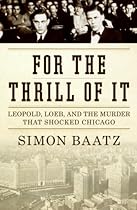Dec. 9, 2010
by Denise Noe
Historian Simon Baatz has written a 541-page book entitled For the Thrill of It: Leopold, Loeb, and the Murder that Shocked Chicago about the murder of 14-year-old Bobby Franks. It is divided into three sections: “The Crime,” “The Attorneys,” and “The Courtroom.”
Baatz hooks the reader into the story immediately when he begins it as follows: “Flora Franks glanced at the clock. Already past six o’clock still no sign of Bobby!” The author soon familiarizes us with the Franks family and the son who has failed to make it home. Mom Flora is immediately fearful that something bad has happened to the boy while Dad Jacob is “annoyed” because he assumed that the boy was with a friend and had just ignored the time.
Another way Baatz makes us want to read more is by bringing Bobby to life. Baatz writes that Bobby was “the darling of the family” but “a bit of a scamp who got into his share of scrapes at school.”
In a crisp, highly readable style, Baatz recreates the terrible tension suffered by the Franks family, the hopes raised when they were contacted by a kidnapper, and finally the crushing disappointment and grief when Bobby’s dead body was discovered in a culvert the day after his kidnapping.
Baatz goes on to describe the city’s outrage, the hunt for the murderers, and the public shock when they were found to be 19-year-old Nathan Leopold and 18-year-old Richard Loeb, scions of Chicago’s wealthiest families. Public outrage was magnified when it was learned that they had kidnapped, murdered, and then tried to extort ransom from the family of their victim after killing him “for the thrill” of committing what they had hoped would be the “perfect crime.”
For the Thrill of It leads the reader into the troubled, albeit materially pampered, lives of the two murderers. It acquaints us with Nathan Leopold, a frequently teased and bullied boy whose mother was an invalid after his birth and whose governess seduced him when he was 12 years old. We also get to know Richard Loeb, who was secretly fascinated with crime and yearned for a career in the criminal underworld even as he attempted to please his own overbearing governess who insisted he concentrate single-mindedly on academics. We learn how Leopold and Loeb became friends and then lovers and how they exacerbated the worst aspects of each other’s psychological tendencies, eventually culminating in their decision to commit murder.
“The Attorneys” section of the book bogs down. Baatz gives extensive background on Clarence Darrow, whose life story is familiar to many students of true crime. He gives an equally detailed background on prosecutor Robert Crowe. There is far too much information about them than is necessary or desirable in a book about the Leopold and Loeb case and it causes the story to needlessly slow.
It picks back up again in “The Courtroom.” Baatz presents the decision of Darrow to plead his young clients guilty rather than try an insanity defense in hopes of averting the death penalty by presenting the “mitigating circumstances” of their psychological abnormalities. The book does a good job of depicting the warring “alienists” of defense and prosecution, but does not provide enough space to Darrow’s impassioned summation, an eloquent plea for mercy.
Two different reviewers quoted on the back cover blurb of For the Thrill of It laud the book as the “definitive” account of the Leopold and Loeb case. It is not. Baatz only skims over the lives of the murderers during their prison years. There is considerable data on this period of their lives in Hal Higdon’s Crime of the Century and Nathan Leopold’s memoirs of his life behind bars, Life Plus 99 Years.
The book would have benefited if it had discussed Richard Loeb’s plan to write a book on the history of the Civil War. Baatz does discuss Loeb’s violent death when he was stabbed by Richard Day. However, Baatz appears to accept Day’s story that he stabbed multiple times in self-defense because Loeb attempted to sexually assault Day. Although Day was acquitted, this story seems far-fetched given that Loeb had suffered fifty-six stab wounds. It seems likely that, as Hal Higdon observed, the jury simply did not want to punish the murderer of Richard Loeb.
For the Thrill of It tells us little about Leopold’s life once he was freed. Some of what Baatz writes is misleading. He reports, “In 1963 Nathan won his release from parole. Finally he could drink alcohol, drive an automobile, and stay out at night.” However, as Hal Higdon wrote in Crime of the Century, Leopold had done all of those things almost as soon as he was paroled. Higdon also noted that these actions were especially troubling in a man whose terrible crime was motivated in large part because he felt himself above the rules that governed ordinary people.
Baatz also gives scant attention to the fictional representations of the case. That is unfortunate since the Bobby Franks murder was the inspiration for Alfred Hitchcock’s Rope and the extraordinarily powerful novel Compulsion by Meyer Levin. Baatz derides Levin’s “writing style” in Compulsion as “overwrought, exaggerated, and fanciful.” However, Levin’s fictional treatment deserves much fuller attention than Baatz gives it, as Levin was able to make psychological sense out of the crime to a degree that neither the psychiatrists who testified at the trial nor the attorneys who argued at it were able to.
For the Thrill of It: Leopold, Loeb, and the Murder that Shocked Chicago provides a good, solid introduction to the facts surrounding the murder of Bobby Franks and the trial of his two brilliant but sociopathic murderers. The short shrift given to the post-trial lives of Leopold and Loeb as well as to the media depictions of the case make it far from definitive.
The truly definitive work on the case has yet to be written.









